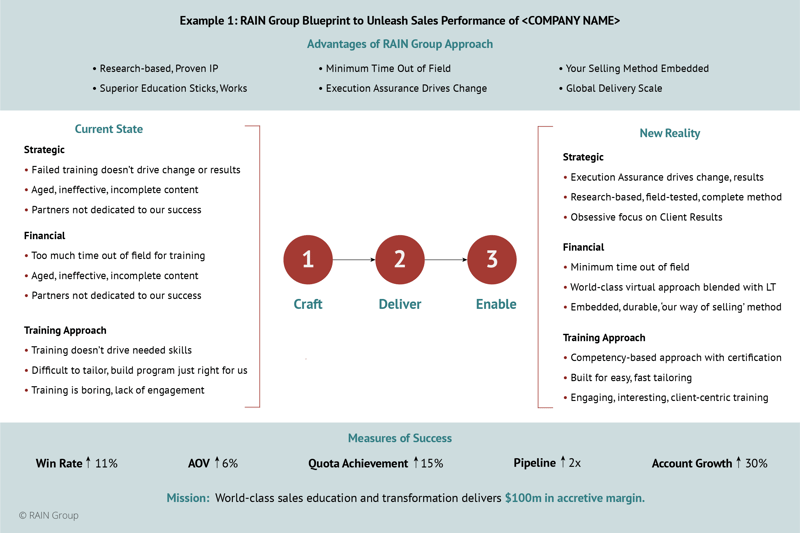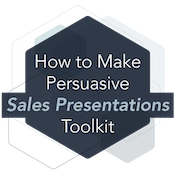You’ve worked on building rapport with your prospect and you’ve uncovered their aspirations and afflictions. The question then becomes, "So what?"
If your afflictions don't get solved, so what? What won’t happen? Will they get worse? How will they affect the bottom line of your company, division, or department? How will they affect your life?
If your aspirations don't become reality, so what? Will your competition get ahead of you if you don't innovate? Will you lose market share if you aren't aggressive in your strategy? Will you never be able to grow your business to a point where you can sell it and reach your personal financial goals? Will the promotion you desire continue to elude you?
Your ability to quantify the impact and paint the "so what" picture is the foundation for how important it is for the decision maker to buy from you. If you don’t answer the "so what" question, the initiative will fall to the bottom of the priority list.
Your value proposition may be a thorough rundown of the benefits of working with you, but your impact (both business and emotional!) is what spurs the buyer to move forward with you.
Make the impact clear, and the prospect's perception of the gap between where they are and where they want to be grows to its widest. Impact is the I in RAIN Selling.
6 Ways to Demonstrate Impact in Sales Conversations
1. Calculate the Business Impact
Each affliction that you solve and each aspiration that you help a prospect realize will ultimately have a financial impact. Simply put, you should be able to make the business case for the financial effects of engaging your products and services.
Presenting a strong ROI case is central to conveying your business impact, but it isn’t everything. The context matters as much as the numbers—even if you think your case is impressive, you’re still trying to stand out in a sea of other offers. Craft your ROI with the buyers’ needs in mind, or better yet, build the case together with the buyer. The more you can involve the buyer, the more they'll believe it’s possible.
Read: 4 Misconceptions of Making a Strong ROI Case
2. Communicate Emotional Impact
Increased prestige. A more enjoyable day. Faster promotions. Ability to relax on the weekend. Enjoying your sparkling personality. Peace of mind. There are many non-financial influences on the sale that can tip the scales in your favor.
Think about emotional impact in terms of opportunities. What opportunities can your solution create for the buyer? Alternatively, what opportunities might they miss out on if they don’t move forward? These can range from benefits for individuals to opportunities that impact the entire organization.
3. Impact Compared to the Alternative
You need to know the impact of your solution and the impact of alternative solutions to you. Perhaps your company offers better ROI, their products are inferior, or your service is better. Know the alternatives and you can make the best case for achieving success with you.
This illustrates the importance of differentiation. If you fail to differentiate, the buyer will fall back on surface-level factors, like price, and view potential solutions as largely interchangeable. The buyer might pressure you on price or arbitrarily choose someone else.
This is why differentiation is one of the three legs of your value proposition.
4. What Won’t Happen?
Sometimes the prospect sees the positive impact of buying from you but doesn’t see the negative impact of not moving forward. The result can be a slow decision-making process. If this is the case, you can ask the prospect what won’t happen if they don’t move forward. By doing this, you probe for consequences of inaction and move yourself higher up the prospect’s to-do list.
To convince the buyer of the urgency and necessity of your solution, you must resonate with them. This means digging deep into their current afflictions and educating them on how you can help enact positive change. If you don’t resonate, the buyer won’t feel motivated to move quickly on a decision—if they move forward at all.
Asking what won't happen is 1 of 7 key questions to uncover impact and ROI.
5. Build Credibility with Similar Impact
Buyers have aspirations and afflictions. You’re selling what they need to help them meet their goals. The value proposition is clear, but they’re still unsure. Buyers often want to know if you’ve been there before and what happened.
Share case studies and stories of how you’ve helped other clients overcome similar challenges or achieve similar priorities. Tailor the story as much as possible to match the buyers’ situation. Share stories of clients in similar industries, of similar size, and facing similar challenges. The more similar the client story the more it will resonate with the buyer. Furthermore, focus on the results you helped the client achieve. You’ll build credibility through similar impact.
6. Demonstrate Impact Tangibly
The more you can make the impact tangible, the stronger your impact case will be. In essence, you need to paint a tangible picture of what is going to change for them if they engage your products and services. A before and after table or graphic can make all the difference. The example below uses RAIN Group's Buyer Change Blueprint.
How to Plan Your Impact Case

It’s challenging to improvise an impact case. A good impact case makes use of both your prior industry expertise and insights gleaned from speaking with a prospect. By planning out your impact case—most often by building an impact model—you display your understanding of the buyer’s situation and can educate them on new possibilities.
Your impact model will be different for every prospect. It takes work to do well, but when you know how to ask the right questions and lead incisive conversations, it gets easier to understand where your buyer is and how you can make a difference for them.
Get Your Buyers Excited
Show someone a way to improve results, solve problems, and make more money, and suddenly that person feels stress drop away, is excited to make a difference, and anticipates greater success and worry-free weekends. You’ll make the sale and you’ll both be happier for it.
Fail to demonstrate the impact in your sales conversations, and you won’t capture the prospect’s interest and desire, you won’t take them on an emotional journey, and they won’t feel that it’s important enough to put your agenda on top of their to-do list.








